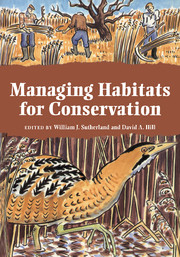Book contents
- Frontmatter
- Contents
- List of Contributors
- Acknowledgements
- 1 Introduction and principles of ecological management
- 2 Site management planning
- 3 Access
- 4 Coastal habitats
- 5 Rivers, canals and dykes
- 6 Waterbodies
- 7 Reedbeds, fens and acid bogs
- 8 Grasslands
- 9 Farmland
- 10 Lowland heathland
- 11 Upland moors and heaths
- 12 Woodland and scrub
- 13 Urban areas
- Some useful addresses
- Index of species by common names
- Subject index
7 - Reedbeds, fens and acid bogs
Published online by Cambridge University Press: 05 February 2015
- Frontmatter
- Contents
- List of Contributors
- Acknowledgements
- 1 Introduction and principles of ecological management
- 2 Site management planning
- 3 Access
- 4 Coastal habitats
- 5 Rivers, canals and dykes
- 6 Waterbodies
- 7 Reedbeds, fens and acid bogs
- 8 Grasslands
- 9 Farmland
- 10 Lowland heathland
- 11 Upland moors and heaths
- 12 Woodland and scrub
- 13 Urban areas
- Some useful addresses
- Index of species by common names
- Subject index
Summary
Introduction
Reedbed, fen and acid bog habitats are generally part of the succession from open water to woodland, differences between them being due to water chemistry, hydrology, geology and climate. Naturally developing successions of all these habitats have considerable conservation significance. However, in many British reedbeds and fens, lack of management has allowed succession to proceed which has produced large areas of woodland, with relatively small areas of early succession open vegetation communities remaining. Hence conservation management in these habitats now tends to focus on the early successional stages, and generally aims to slow or halt the succession. In contrast, many of the open acid bogs remaining in Britain are relatively stable and often require low levels of management, or even none at all. They are, however, threatened by peat extraction, drainage and invasion or afforestation by exotic conifers.
The three habitats vary widely in the vegetation communities and the associated animals that they support. Management experience for reedbeds, fens and acid bogs is summarised in this chapter.
Reedbed, fens and acid bog communities
Reedbeds
Reedbeds are dominated by Common Reed Phragmites australis. Wheeler (1992) defined a pure reedbed as a stand where the Phragmites cover exceeded 90% and an impure reedbed where the Phragmites cover exceeded 75% but was less than 90%. He considered that any stand of vegetation containing Phragmites in lesser proportion than 75% cover constituted a fen community.
- Type
- Chapter
- Information
- Managing Habitats for Conservation , pp. 149 - 196Publisher: Cambridge University PressPrint publication year: 1995
- 8
- Cited by

